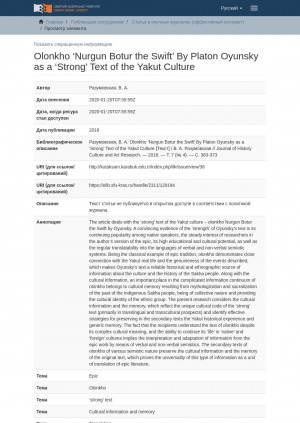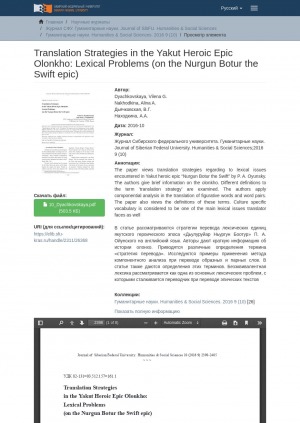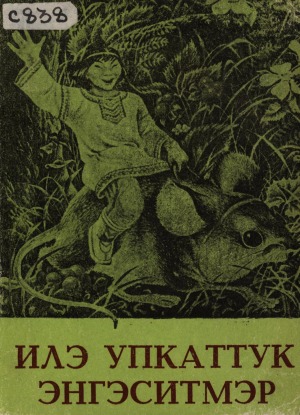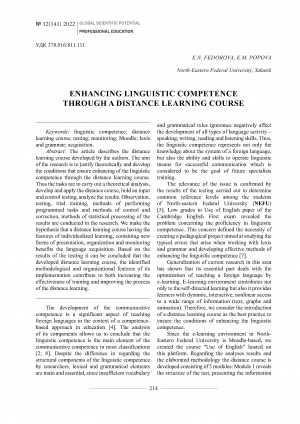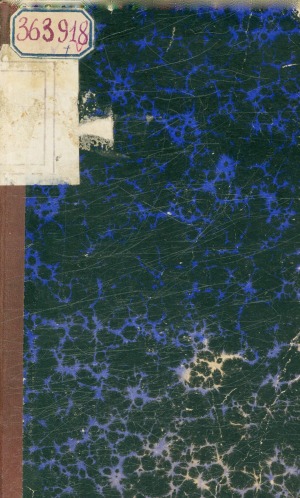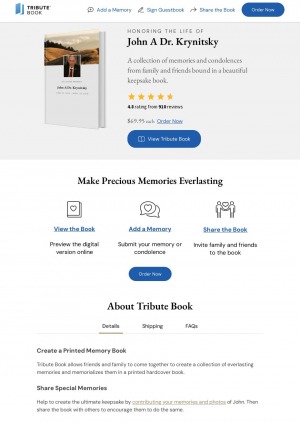Отраслевые подборки (УДК)
Издания подборки 1 - 10 из 141
- Книга (4957)
- Газета (30)
- Журнал (272)
- Автореферат диссертации (573)
- Изоиздание (3)
- Аудиоиздание (19)
- Видеоиздание (218)
- Картографическое издание (4)
- Неопубликованный документ (610)
- Нотное издание (16)
- Фотография (17)
- Статья (3193)
- Библиографический указатель (84)
- Словарь (11)
- Календарь (8)
- Брошюра (107)
- Буклет (32)
- Электронное издание (2)
- 3D-модель (15)
- Грампластинка (13)
- Веб-архив (779)
- Бурятский (2)
- Чукотский (8)
- Долганский (2)
- Английский (121)
- Эскимоский (3)
- Эвенкийский (11)
- Эвенский (52)
- Французский (17)
- Немецкий (6)
- Хантыйский (1)
- Киргизский (1)
- Корейский (1)
- Мансийский (1)
- Нанайский (1)
- Ненецкий (4)
- Нганасанский (2)
- Нивхский (1)
- Старорусский (9)
- Польский (4)
- Русский (9287)
- Латинская графика (76)
- Испанский (1)
- Таджикский (1)
- Тунгусский (2)
- Турецкий (5)
- Ульчский (1)
- Узбекский (1)
- Якутский (1332)
- Юкагирский (12)
- Литературно-художественные издания (541)
- Официальные издания (1111)
- Научные издания (4338)
- Научно-популярные издания (1969)
- Информационные издания (1419)
- Справочные издания (57)
- Учебные издания (930)
- Производственно-практические издания (21)
- Массово-политические издания (551)
- Изобразительное издание (26)
Год выпуска: 2018
In the years 1997 and 2017 in Evenkia, comprehensive studies in the form of a mass survey were carried out. They revealed some significant changes in the household, various aspects of material and spiritual culture. The scale of reindeer breeding has dramatically dropped; at the present moment, around 1/10 of the Evenk families are engaged in it. Hunting and fishing are preserved better: almost one third of all men are engaged in them. The overwhelming majority of men continue hunting and fishing at the amateur level, just like the major part of women maintain their sewing and beadwork skills. The language assimilation process is very active; children hardly speak or understand their mother tongue, though the majority of the Evenks study it at school. The share of mixed families, mostly with Russians, has reached fifty per cent: the majority of children from these families get assimilated with the Evenk ethnicity. As a result of such marriages, the share of people of mixed descent among the Evenks is approaching two thirds, while among the children this share has reached 9/10. The Evenks are mixing with other ethnicities and acquire Russian language, but maintain a stable ethnic self-consciousness and preserve certain elements of their traditional culture in some aspects of material and spiritual culture
В 1997 и в 2017 годах в Эвенкии были проведены комплексные исследования по современным этническим процессам с использованием метода массового опроса. Выявлены существенные изменения в хозяйстве, в разных областях материальной и духовной культуры. Резко снизилось значение оленеводства, в настоящее время в нем заняты около 1/10 части эвенкийских семей. Лучше сохранились охота и рыболовство, в них занята почти треть мужчин. На любительском уровне охотой и рыболовством занимается подавляющее большинство мужчин, а значительная часть женщин не утеряли навыков шитья и вышивки бисером. Активно идет процесс языковой ассимиляции, дети практически не говорят на языке эвенков и не понимают его, хотя большинство эвенков изучает родной язык в школе. Количество национально-смешанных семей, в основном с русскими, приблизилось к половине всех семей, большинство детей вливаются в эвенкийский этнос. В результате этих браков доля метисов среди эвенков приближается к 2/3, а среди детей их доля достигла 9/10. Эвенки превращаются в группу русскоязычных метисов, но с устойчивым этническим самосознанием и с сохранением элементов традиционной культуры в некоторых областях материальной и духовной культуры
В 1997 и в 2017 годах в Эвенкии были проведены комплексные исследования по современным этническим процессам с использованием метода массового опроса. Выявлены существенные изменения в хозяйстве, в разных областях материальной и духовной культуры. Резко снизилось значение оленеводства, в настоящее время в нем заняты около 1/10 части эвенкийских семей. Лучше сохранились охота и рыболовство, в них занята почти треть мужчин. На любительском уровне охотой и рыболовством занимается подавляющее большинство мужчин, а значительная часть женщин не утеряли навыков шитья и вышивки бисером. Активно идет процесс языковой ассимиляции, дети практически не говорят на языке эвенков и не понимают его, хотя большинство эвенков изучает родной язык в школе. Количество национально-смешанных семей, в основном с русскими, приблизилось к половине всех семей, большинство детей вливаются в эвенкийский этнос. В результате этих браков доля метисов среди эвенков приближается к 2/3, а среди детей их доля достигла 9/10. Эвенки превращаются в группу русскоязычных метисов, но с устойчивым этническим самосознанием и с сохранением элементов традиционной культуры в некоторых областях материальной и духовной культуры
Год выпуска: 2022
The objective of the study is to reveal the main techniques of the translation of the Yakut Olonkho epos “Ala-Bulkun” into Russian, made by the Yakut linguist and writer G.V. Baishev – Altan Sarin (1898-1931). The study is based on the verbs of motion and some main epic formulae used in this Olonkho epos. The analysis of the techniques used for translation of the Yakut verbs of motion into Russian showed that the verbs are translated with the reformulation technique. It suggests that the translator sought to adequately communicate the semantics of the Yakut verbal forms. This, in turn, is determined by the fact that verbal forms as predicative structures are the heads of both dependent and independent predicative structures. The epic formulae are translated using parallelism or by dividing the sentence into several sentences. Besides, to expand the context in order to reveal the translated information more slowly, the repetition technique is used. It was found that the translation under consideration demonstrates some elements of authorized translation. The studies of Olonkho translation techniques aimed at communicating the stylistic and poetic features of this Yakut folklore genre are of both theoretical and practical importance
Целью и задачами статьи является выявление основных способов перевода на русский текста якутского героического эпоса олонхо "Ала-Булкун", осуществленного якутским лингвистом и писателем Г.В. Баишевым-Алтан-Сарын (1898-1931). В качестве материала исследования были выбраны глаголы движения и некоторые основные эпические формулы, использованные в данном олонхо. Анализ способов перевода на русский язык якутских глаголов движения показывает, что эти глаголы переведены на русский язык способом замены. Подобный факт свидетельствует о том, что переводчик стремился точно передать семантику якутских глагольных форм на русский язык. Это, свою очередь, обусловлено тем, что глагольные формы как предикативные структуры являются вершинами тех или иных предикативных конструкций – зависимых или независимых. Эпические формулы переведены при помощи синтаксической замены – параллелизмами, а также расчленением предложения на несколько предложений. Кроме того, встречаются лексические и синтаксические повторы для расширения контекста с целью более медленного раскрытия передаваемой информации. Установлено, что в рассмотренном переводном тексте имеют место элементы авторизованного перевода. Изучение особенностей подобных переводов олонхо, ориентированных на воспроизведение стилистических и поэтических особенностей данного жанра якутского фольклора, имеет как практическое, так и теоретическое значение
Целью и задачами статьи является выявление основных способов перевода на русский текста якутского героического эпоса олонхо "Ала-Булкун", осуществленного якутским лингвистом и писателем Г.В. Баишевым-Алтан-Сарын (1898-1931). В качестве материала исследования были выбраны глаголы движения и некоторые основные эпические формулы, использованные в данном олонхо. Анализ способов перевода на русский язык якутских глаголов движения показывает, что эти глаголы переведены на русский язык способом замены. Подобный факт свидетельствует о том, что переводчик стремился точно передать семантику якутских глагольных форм на русский язык. Это, свою очередь, обусловлено тем, что глагольные формы как предикативные структуры являются вершинами тех или иных предикативных конструкций – зависимых или независимых. Эпические формулы переведены при помощи синтаксической замены – параллелизмами, а также расчленением предложения на несколько предложений. Кроме того, встречаются лексические и синтаксические повторы для расширения контекста с целью более медленного раскрытия передаваемой информации. Установлено, что в рассмотренном переводном тексте имеют место элементы авторизованного перевода. Изучение особенностей подобных переводов олонхо, ориентированных на воспроизведение стилистических и поэтических особенностей данного жанра якутского фольклора, имеет как практическое, так и теоретическое значение
Год выпуска: 2022
The article presents the development of the sub-ethnic group of the Yessei Yakuts in the aspects of landscape, history, and memory. The research is dedicated to the studies of the peripheral ethno-local group of the Yessei Yakuts, resident in the compact area by Yessei lake of the Krasnoyarsk Territory (Krai) since the 18th century. Based on the field research data, the methods of survey, mapping, and deep interview are implemented; the previously unpublished archive materials and narrative materials are introduced into the research discourse
Настоящая статья представляет формирование субэтнической группы якутов в исследовательской траектории: ландшафт, история, память и посвящена изучению периферийной этнолокальной группы ессейских якутов, компактно проживающих на озере Ессей Красноярского края с XVIII века. На основе полевых материалов реализованы методы опроса, картографирования, глубинного интервью, введены в научный оборот ранее не опубликованные архивные материалы, нарративные источники
Настоящая статья представляет формирование субэтнической группы якутов в исследовательской траектории: ландшафт, история, память и посвящена изучению периферийной этнолокальной группы ессейских якутов, компактно проживающих на озере Ессей Красноярского края с XVIII века. На основе полевых материалов реализованы методы опроса, картографирования, глубинного интервью, введены в научный оборот ранее не опубликованные архивные материалы, нарративные источники
Год выпуска: 2018
The article deals with the ‘strong’ text of the Yakut culture – olonkho Nurgun Botur the Swift by Oyunsky. A convincing evidence of the ‘strength’ of Oyunsky’s text is its continuing popularity among native speakers, the steady interest of researchers in the author’s version of the epic, its high educational and cultural potential, as well as the regular translatability into the languages of verbal and non-verbal semiotic systems. Being the classical example of epic tradition, olonkho demonstrates close connection with the Yakut real life and the genuineness of the events described, which makes Oyunsky’s text a reliable historical and ethnographic source of information about the culture and the history of the Sakha people. Along with the cultural information, an important place in the complicated information continuum of olonkho belongs to cultural memory resulting from mythologization and sacralization of the past of the indigenous Sakha people, being of collective nature and providing the cultural identity of the ethnic group. The present research considers the cultural information and the memory, which reflect the unique cultural code of the ‘strong’ text (primarily in translingual and transcultural prospects) and identify effective strategies for preserving in the secondary texts the Yakut historical experience and generic memory. The fact that the recipients understand the text of olonkho despite its complex cultural meaning, and the ability to continue its ‘life’ in ‘native’ and ‘foreign’ cultures implies the interpretation and adaptation of information from the epic work by means of verbal and non-verbal semiotics. The secondary texts of olonkho of various semiotic nature preserve the cultural information and the memory of the original text, which proves the universality of this type of information as a unit of translation of epic literature
В статье рассматривается "сильный" текст якутской культуры - олонхо "Нюргун Боотур Стремительный" Ойунского. Убедительным свидетельством "силы" текста Ойунского является его неизменная популярность среди носителей языка, устойчивый интерес исследователей к авторской версии эпоса, его высокий образовательный и культурный потенциал, а также регулярная переводимость на языки вербальной и невербальной семиотических систем. Являясь классическим образцом эпической традиции, олонхо демонстрирует тесную связь с реальной жизнью якутов и подлинность описываемых событий, что делает текст Ойунского надежным историко-этнографическим источником сведений о культуре и истории народа саха. Наряду с культурной информацией важное место в сложном информационном континууме олонхо занимает культурная память, возникающая в результате мифологизации и сакрализации прошлого коренного народа саха, имеющая коллективный характер и обеспечивающая культурную идентичность этнической группы. В настоящем исследовании рассматриваются культурная информация и память, отражающие уникальный культурный код "сильного" текста (прежде всего в транслингвистической и транскультурной перспективах), и выявляются эффективные стратегии сохранения во вторичных текстах якутского исторического опыта и родовой памяти. Понимание реципиентами текста олонхо, несмотря на его сложный культурный смысл, и способность продолжать его "жизнь" в "родной" и "чужой" культурах предполагает интерпретацию и адаптацию информации эпического произведения средствами вербальной и невербальной семиотики. Вторичные тексты олонхо различной семиотической природы сохраняют культурную информацию и память об оригинальном тексте, что доказывает универсальность данного типа информации как единицы перевода эпической литературы
В статье рассматривается "сильный" текст якутской культуры - олонхо "Нюргун Боотур Стремительный" Ойунского. Убедительным свидетельством "силы" текста Ойунского является его неизменная популярность среди носителей языка, устойчивый интерес исследователей к авторской версии эпоса, его высокий образовательный и культурный потенциал, а также регулярная переводимость на языки вербальной и невербальной семиотических систем. Являясь классическим образцом эпической традиции, олонхо демонстрирует тесную связь с реальной жизнью якутов и подлинность описываемых событий, что делает текст Ойунского надежным историко-этнографическим источником сведений о культуре и истории народа саха. Наряду с культурной информацией важное место в сложном информационном континууме олонхо занимает культурная память, возникающая в результате мифологизации и сакрализации прошлого коренного народа саха, имеющая коллективный характер и обеспечивающая культурную идентичность этнической группы. В настоящем исследовании рассматриваются культурная информация и память, отражающие уникальный культурный код "сильного" текста (прежде всего в транслингвистической и транскультурной перспективах), и выявляются эффективные стратегии сохранения во вторичных текстах якутского исторического опыта и родовой памяти. Понимание реципиентами текста олонхо, несмотря на его сложный культурный смысл, и способность продолжать его "жизнь" в "родной" и "чужой" культурах предполагает интерпретацию и адаптацию информации эпического произведения средствами вербальной и невербальной семиотики. Вторичные тексты олонхо различной семиотической природы сохраняют культурную информацию и память об оригинальном тексте, что доказывает универсальность данного типа информации как единицы перевода эпической литературы
Год выпуска: 2016
The paper views translation strategies regarding to lexical issues encountered in Yakut heroic epic “Nurgun Botur the Swift” by P. A. Oyunsky. The authors give brief information on the olonkho. Different definitions to the term ‘translation strategy’ are examined. The authors apply componential analysis in the translation of figurative words and word pairs. The paper also views the definitions of these terms. Culture specific vocabulary is considered to be one of the main lexical issues translator faces as well
В статье рассматриваются стратегии перевода лексических единиц якутского героического эпоса "Дьулуруйар Ньургун Боотур" П. А. Ойунского на английский язык. Авторы дают краткую информацию об истории олонхо. Приводятся различные определения термина "стратегия перевода". Исследуются примеры применения метода компонентного анализа при переводе образных и парных слов. В статье также даются определения этих терминов. Безэквивалентная лексика рассматривается как одна из основных лексических проблем, с которыми сталкивается переводчик при переводе эпических текстов
В статье рассматриваются стратегии перевода лексических единиц якутского героического эпоса "Дьулуруйар Ньургун Боотур" П. А. Ойунского на английский язык. Авторы дают краткую информацию об истории олонхо. Приводятся различные определения термина "стратегия перевода". Исследуются примеры применения метода компонентного анализа при переводе образных и парных слов. В статье также даются определения этих терминов. Безэквивалентная лексика рассматривается как одна из основных лексических проблем, с которыми сталкивается переводчик при переводе эпических текстов
Издательство: Книгады издательства
Год выпуска: 1987
Количество страниц: 100 с.
Подборки
- Сказочный мир > Сказки народов Севера и авторские сказки,
- Сказки Северного сияния,
- Общественные науки. Образование,
- КНИГАКАН > Все народы > Эвенки (тунгусо-маньчжурская группа языков) > Этнография. Фольклор,
- ШКОЛА > Школьнику > Литература > Литература коренных малочисленных народов Севера,
- Школа 2 > Педагогу > Методика преподавания дисциплин > Гуманитарные науки,
- Школа 2 > Предметные подборки > Художественная литература > Литература КМНС.
Авторы:
Количество страниц: 3 с.
Подборки
- Общественные науки. Образование > Народное образование. Воспитание. Обучение. Организация досуга > Высшее образование. Высшая школа. Подготовка научных кадров,
- НАУКА ЯКУТИИ > ОБЩЕСТВЕННЫЕ НАУКИ > Народное образование. Воспитание. Обучение. Организация досуга > Высшее образование. Высшая школа. Подготовка научных кадров.
Fedorova, E. N. Enhancing linguistic competence through adistance learning course / Fedorova E. N., Popova E. M. ; M. K. Ammosov North-Eastern Federal University // Глобальный научный потенциал. - 2022. - N 12 (141). - С. 214-216.
Заглавие:
John A Dr. Krynitsky: [tribute book]
Год выпуска: 2006
Книга воспоминаний о докторе Джоне А. Криницком



